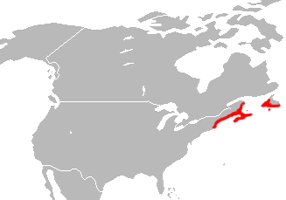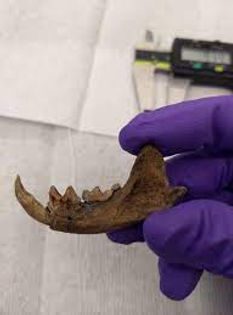Creature
Fast Facts
Introducing you to extinct species.

THE
SEA MINK
1. The sea mink, Neogale macrodon, was 50% larger and redder than the American mink. 2. Scientists debate about whether the sea mink was a sub species of the American mink or its own species. 3. The sea mink was 32 inches long. 4. They were semi-aquatic" which means they did not live at sea. 5. They were found primarily in the Gulf of Maine but could range as far as Newfoundland to Massachusetts. 6. Mink fur has always been prized for its qualities. Mink farms exist around the world today. It takes 50 - 60 minks to make one fur coat. 7. Their diet included invertebrates, fish, insects, and sea bird eggs, probably even those of the extinct Labrador duck. 8. The sea minks were polygynandrous & males were larger than the females. 9. Studies have shown that the specimen collected in 1894 was probably a hybrid between the sea mink & American mink. 10. The only confirmed specimens known to exist are skulls and jaw bones. No complete specimen is known to exist. 11. In 2018, a possible mount of a sea mink was purchased for $500 by a Canadian scientist to study it. The specimen's name was Ty.
Extinction
Cometh
Facing the light at the end of the tunnel
EXTINCTION DATE
1880
The sea mink was native to the Gulf of Maine and other areas along the Northeastern Coast of North America. The sea mink was 50% larger than the American mink, which made it a prime target of fur traders from Europe. Its fur was much redder than its American cousin, making it unique and therefore more valuable. Though some scientists think the sea mink was simply a sub species of the American mink that developed regional gigantism, it has proven a difficult thing to prove since the only confirmed specimens are skulls and jaw bones. In 2018, a mounted specimen named "Ty" was purchased from a private owner for $500 to be studied. The sea mink was hunted in the Gulf of Maine and was easier to search for than more aquatic relatives like the sea otter of the North Pacific because the sea mink was semi-aquatic. That means that even though it spent much time in the ocean hunting for fish and invertebrates, it did come back on land. Hunters would use dogs to sniff out the sea mink hiding in coastal caves and crevices. Once located, hunters would smoke the sea mink out and kill them. This proved to be an effective hunting method because by 1880 the last confirmed sea mink was killed in Jonesport, Maine in 1880. There was one additional report of a sea mink in 1894, but the size and color seemed to indicate it was a hybrid between the two mink species. Although Jurassic Park is fiction, scientists are working on several de-extinction projects. In fact, in 2003 scientists did bring back the extinct Pyrenean ibex, a type of wild goat, for 7 minutes before it died, showing de-extinction is possible. The sea mink might be a candidate for de-extinction. Scientists would potentially use DNA from the skulls and jaw bones that have been obtained from museums and private collectors. If "ty" is confirmed to be a sea mink, DNA from Ty's pelt could also be used. If the sea mink did return to the Gulf of Maine, would it be able to survive? Many efforts in the sea mink's home range have been made by the United States & Canada since 1880. Animals like the Atlantic puffin and reestablishing nesting areas in that region again. Hunting regulations and laws like the Endangered Species Act would potentially help the sea minks to survive. Minks have long been raised in captivity for their fur, so breeding them would not be a problem. Once a population was established would they be able to thrive in their home region?
COMING SOON
The sea mink's Lazarus tale has yet to be written, but what adventures will await it when it returns to the Gulf of Maine? Stay tuned to find out.
More to Explore
All answers lead to more questions

Historic Range of the sea mink
Image from Google Maps
VIDEOS & ADDITIONAL INFO
CBC News - Possibly the Only Extinct Pelt is Found
Sea Mink Stories - Nature Portfolio
Extinct Creature Timeline Including Sea Mink (1880) - Video
Sea Otter Facts from Monterey Bay Aquarium

Sketch of a sea mink
Image from Extinct Animals

This pelt is being studied as possibly the only sea mink specimen in existence
Image from Meateater



The skulls of an American mink and a Sea Mink
Image from Nature Portfolio
Picture of the largest sea mink jaw bone fragment
Image from Nature Portfolio
Painting of a sea mink
Image from Scii Fii Wiki

"Covid Mink" - a mink in Utah was the first wild animal to test positive for Covid-19
Image from Science News

A Photo of the Smaller American Mink
Image from Animal Picture Archives

Cartoon sea mink
Image from Fur Affinity

A full size sea mink statue sells for $9,000
Image from Forest Heart

Mink are raised on farms for their fur
Image from Red Bubble

The sea otter was almost hunted to extinction for its fur on the west coast of North America
Image from Marine Conservation Institute

A sea otter mom and pup
Image from Seattle Times

A sea otter episode of Wild Kratts
Image from You Tube



